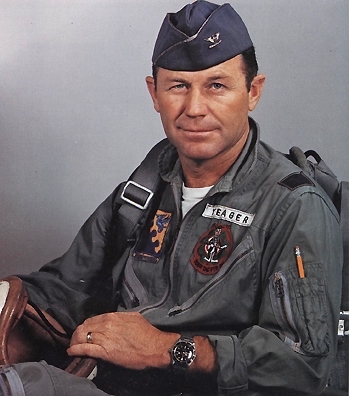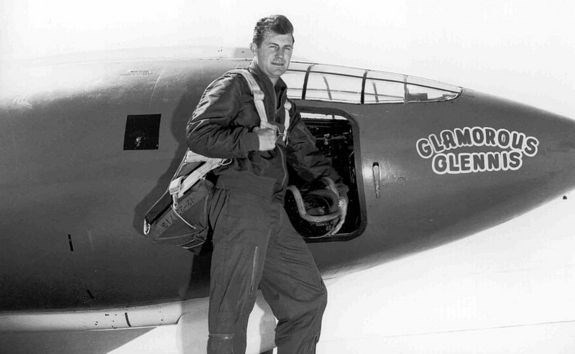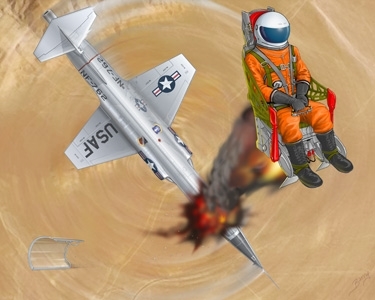 |
| Portrait of Yeager (http://www.achievement.org/autodoc/page/yea0bio-1 (Air Force Flight Test Center)) |
"The thing about a hero, is even when it doesn't look like there's light at the end of the tunnel, he's going to keep digging, he's going to keep trying to do whats right and make up for what's gone before." (Joss Whedon). This is exactly what was done by Chuck Yeager. Pushing on in impossible situations to complete a job that was started by those before him. Born in 1923, Chuck Yeager got his start as a WWII Pilot on the European and African front ("Chuck Yeager." Encyclopedia). After returning from WWII, Yeager signed up to become a USAF test pilot at Edwards AFB ("Chuck Yeager." Contemporary). This is where Yeager achieved some of his most famous accomplishments such as breaking Mach 1 and Mach 2.5 for the first time. After 1954, Yeager worked as a "Part-time" test pilot for the air force, while he tested Soviet Nuclear Bombers in Japan (World Biography). Yeager retired in 1975 ("Chuck Yeager." Contemporary). Although many people thought that Yeager was crazy for attempting these test flights, he still pushed on in the name of breaking barriers once thought to be impossible. Through his courage of breaking deadly barriers of speed once thought to be impossible, and risking his life to push the limits of reachable altitude, Yeager is considered to be one of the biggest inspirations and heroes in Aviation.
 |
| Yeager just moments before the Mach 1 test flight (http://www.space.com/16709-breaking-the-sound-barr (Air Force Test Center History Office)) |
Chuck Yeager pushed the known limits of speed and G force to break the sound barrier. Chuck Yeager continued on through intense shaking of the plane as he reached mach 1. But he did not know what would happen once he reached the sound barrier:
He entered the X-1 and locked himself in at 7,000 feet. The B-29 released the X-1 at 26,000 feet. At .87 Mach the violent vibrations began, but Yeager continued to push the aircraft faster. Just as he had predicted, at .96 Mach the aircraft steadied and he passed Mach 1. At that moment a giant roar was heard on the desert at the experimental test site--the first man-made sonic boom. Yeager reached Mach 1.05 and stayed above Mach 1 for seven minutes. ("Chuck Yeager." Encyclopedia).
Chuck Yeagers personal belief was that the aircraft would steady as he passed the sound barrier, but he did not know if the rattling would become worse. And if the aircraft would break up as he approached the sound barrier, just as what happened to those before him. He risked his life not knowing the outcome of the flight, to try break the sound barrier. Just a few days earlier Chuck Yeager broke his ribs during a horseback ride:
The date of October 14, 1947 was set for breaking the "sound barrier." On the night of October 12, Yeager went horseback riding and fell off the horse. The next day his right side was in a great deal of pain. Afraid of being taken off the flight, he drove to a local town and saw the doctor there who told him that he had broken two ribs." ("Chuck Yeager." Encyclopedia).
Unaware of what the G force might do to his body with the broken ribs, he continued along with the flight anyway. Since little is known about high g force on the body at the time, he didn't know if the broken ribs would push back on his organs from acceleration, and crush his organs. But he continued with the flight anyway. Chuck Yeagers continuation through moments that seems deadly and impossible, truly shows that Yeager is a brave person.
 |
| Yeager as he ejects from the NF-104a (http://www.check-six.com/Crash_Sites/NF-104A_crash (Barry Munden)) |
One of Chuck Yeagers lesser known feats was the attempt at reaching the highest possible altitude with a jet engine, in 1963. Yeager continued through with his flight as he was reaching the engine shutoff point, but that's when it all went wrong. "Then, when he attempted to lower the nose at the peak of his climb, he found that neither the aerodynamic controls nor the reaction controls could reduce the angle of attack enough to prevent a spin. Soon he was gyrating in all directions, and nothing would stop it. A mile above the desert and falling like a manhole cover, he ejected." (Marrett). The reason this is heroic is because of how long he held on to the plane. He lost control at 101,585 feet (Marrett), but he only ejected at a mile high, or 5,280 feet. The standard military pilot would eject a few seconds after they noticed a problem, but he waited in hopes of regaining control, almost risking his own life. But after he ejected, things only got worse:
As his parachute opened, he was struck in the face by the base of his rocket (Ejection) seat. His helmet's visor broke and burning residue from the rocket entered the helmet. Pure oxygen for breathing was flowing to the helmet, igniting a flame that started to fry his neck and face. As he descended, Yeager removed a glove and used his bare hand to try to put out the fire around his nose and mouth, charring two fingers and a thumb. (Marrett).
In a situation like this, pilots are trained to cut the oxygen supply to their helmet. But Yeager put out the flame using his bare hands, knowing they would get burnt. His quick thinking saved the skin on his face and neck. Yeagers ability to wait to the last moment, and try to save something in a near impossible situation, makes him a truly brave person.
Chuck Yeager is a true hero for breaking the deadly barriers of speed once thought to be impossible, and risking his life to push the limits of reachable altitude. Yeager did what others were afraid to do, and completed the deadly jobs that were left by those who fatally tried before him. He pushed the limits of what were thought to be possible by human engineering, almost risking his own life, more than once. He broke speed records never before reached not once, but twice. He tried to push the limits of altitude in an experimental aircraft, almost dying in the process. Yeager is a hero to me because he pushed the limits of aviation, pioneering the way for future aviators, and technological feats of engineering. This is why everyone should consider him an inspiration too. His test flight in the Bell X-1 one day in 1947 paved the way for future space exploration, and even today's modern aircraft engines. This is what a true hero must do. They must keep going when there seems like no possible outcome is visible, and they must finish what was started even when the only outcome seems grim.
Works Cited
"Chuck Yeager." Encyclopedia of World Biography. Detroit: Gale, 1998. Biography in Context.
Web. 27 Apr. 2016.
"Chuck Yeager." Contemporary Heroes and Heroines. Vol. 1. Detroit: Gale, 1990. Biography in
Context. Web. 29 Apr. 2016.
Marrett, George J. "Sky High in a Starfighter." Air & Space Magazine. Smithsonian, Nov. 2002.
Web. 11 May 2016.
<http://www.airspacemag.com/history-of-flight/sky-high-3270307/?no-ist>.
Page created on 5/22/2016 12:00:00 AM
Last edited 5/22/2016 12:00:00 AM
